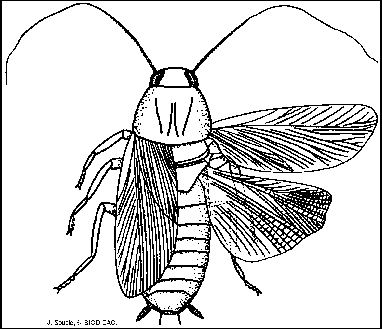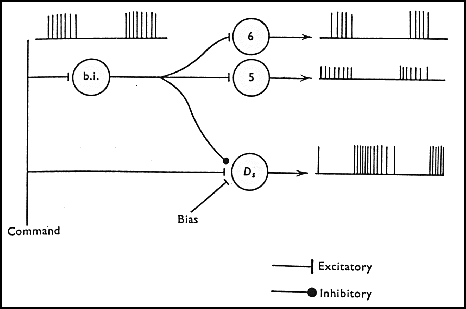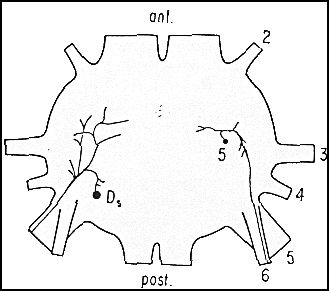
Cockroach, Periplaneta americana

Cockroach, Periplaneta americana
"The cockroach is a primarily nocturnal insect of the order Blattaria. The order contains a number of genera including several that are infamous as domestic pests. The typical domestic cockroach is anywhere between a quarter of an inch and one inch in length, and brown to black in color. Their six-legged, oblong chitinous bodies are adorned with a pair of anteriorally positioned feelers which are often as long as one-third of their overall body length.
Cockroaches typically nest inside walls, ventilation ducts, heating devices, baseboards and similar places. Their preferred nesting sites are in dark, dusty areas free of vibration or noise. They tend not to be seen a great deal during the day, preferring instead to leave their nests at night in search of food and water. Food left outside of sealed plastic containers, dripping taps, and other sources of moisture and organic debris will attract hungry roaches. Conveniently enough, most bathrooms and kitchens provide these in abundance.
Cockroaches can travel within a building by following plumbing lines and eating their way through the very walls themselves, as well as by more obvious means such as doors and windows. Cockroaches are accomplished climbers and can move extremely quickly when threatened. They are hardy creatures, able to survive on a variety of forms of food and with little water. Further, they adapt quickly to poisons and reproduce rapidly. The typical gestation period for a cockroach egg is on the order of a few weeks."
(Quoted from Jerry's Amateur Entomology Corner)
Tree of Life: Blattaria
The behavior being investigated is the simple act of walking, or the rhythmic, sequenced, coordinated movement of the insects' limbs. The act of walking for one limb can be defined as follows:
"The cyclic movement of a walking leg consists of two parts, the power stroke (also stance phase or support phase) and the return stroke (also swing phase or recovery phase). During the power stroke, the leg is on the ground where it can support and propel the body. In a forward-walking animal, this corresponds to a retraction movement of the leg. During the return stroke, the leg is lifted off the ground and swung to the starting position for the next power stroke." (Cruse 1990)
It obviously follows that the behavior is intrinsically cyclic. Furthermove, behavioral evidence has shown that the motion of the 6 legs is coupled in such a way as to produce coordinated walking. Obviously, there has to be some neural circuitry responsible for this cyclic, coordinated behavior. However, from the natural behavior one cannot determine whether the rhythmic nature of the movements is generated by this circuitry or is the result of sensory feedback.
A considerable amount of research has been done in an attempt to answer this question, and the majority of the evidence favors the former over the latter. In other words, the cyclic motor output is generated internally within the neural circuitry (although sensory feedback is important for modulating the actual frequency of motion). The neural circuits that generate this rhythmic output are called Central Pattern Generators and are described in some detail below.
The neural mechanisms underlying the rhythmic motor output were first described by Pearson. (1970) Figure 1 below is a hypothetical diagram of the circuitry that could produce the necessary output. Neurons labeled "5" and "6" are levator motoneurones; "Ds" is a depressor motoneuron. Bursting interneuron "b.i." phasically drives all of these, with excitatory connections to "5" and "6" and inhibitory connections to "Ds".

Figure 1
In later work, Pearson was able to locate the implicated neurons and confirm connections between them. (1975) Figure 2 shows the actual locations of two of the neurons (located in the metathoracic ganglion) described in the figure 1.

Figure 2
Later work has shown that it is actually a collection of neurons rather than a single interneuron (such as "b.i.") that is responsible for generating and maintaining the rhythm. Such networks are known as Central Pattern Generators, and they are currently thought to be responsible for generating a variety of rhythmic behaviors in a variety of animals. (Delcomyn 1980)
Early classics:
Pearson, K. G., and C. R. Fourtner. (1975) Nonspiking Interneurons in the
Walking System of the Cockroach. Journal of Neurophysiology, 38
: 33-52.
Pearson, K. G., and J. F. Iles. (1970) Discharge Patterns of Coxal Levator and Depressor Motoneurones of the Cockroach, Periplaneta Americana. Journal of Experimental Biology, 52 : 139.
Wilson, D. M. (1961) The Central Nervous Control of Flight in a Locust. Journal of Experimental Biology, 38 : 471-490.
Reviews:
Cohen, A. H. (1992) The role of Heterarchical Control in the Evolution of
Central Pattern Generators. Brain, Behavior, and Evolution, 40
: 112-124.
Cruse, H. (1990) What mechanisms coordinate leg movement in walking arthropods? Trends in Neuroscience, 13 : 15-21.
Delcomyn, F. (1980) Neural Basis of Rhythmic Behavior in Animals. Science, 210 : 492-498.
